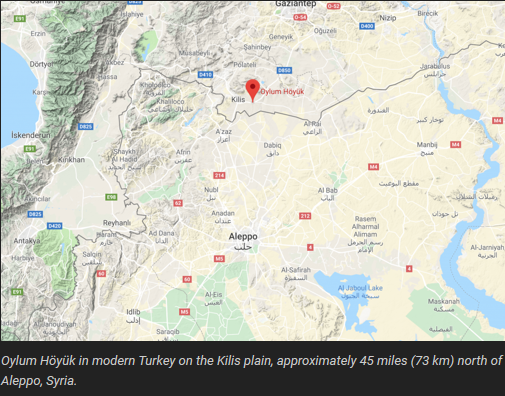
FAIR is a non-profit organization dedicated to providing well-documented answers to criticisms of the doctrine, practice, and history of The Church of Jesus Christ of Latter-day Saints.
FAIR Answers—back to home page
The Book of Abraham talks about a hill known as “Potiphar’s Hill” which is by “Olishem” (Abraham 1:10) in the “land of Ur of Chaldea” (Abraham 1:20). Critics claim that this is an anachronism—citing the lack of inscriptional evidence for this hill as well as a lack of any ancient documents mentioning it.
The claim of no inscriptional or other ancient documentary evidence for the hill is, at this moment[1], true. However, given what we understand about Olishem, we may be able to place a plausible location for the hill itself.
Pearl of Great Price Central writes the following on Olishem:
The opening chapter of the Book of Abraham mentions a location named “the plain of Olishem” (Abraham 1:10). It isn’t clear from the text whether the plain itself was Olishem, or whether some city or region in the area to which the plain was adjacent was Olishem, or if the plain takes its name from a major city on the plain. In any case, this “plain of Olishem” was near Abraham’s homeland of Ur of the Chaldees according to the Book of Abraham.
In 1985, a Latter-day Saint archaeologist named John M. Lundquist published a pioneering article situating the Book of Abraham in a plausible ancient geographical and cultural environment in northern Mesopotamia.[2] Among the points discussed by Lundquist was the plausible identification of Olishem with the ancient place name Ulisum (or Ulishum). Lundquist pointed to inscriptional evidence dating to the time of the Akkadian king Naram Sin (who reigned circa 2254–2218 BC) which spoke of Ulisum in what is today northern Syria or southern Turkey.[3]
Scholars have debated the location of this ancient city and at least half a dozen different sites have been proposed over the years. Subsequent studies have built upon and strengthened this enticing identification of Olishem in the Book of Abraham as the ancient Ulisum.[4] In fact, one non-Latter-day Saint archaeologist working in the area has favorably suggested a possible (though inconclusive) connection between Olishem and Ulisum on linguistic, chronological, and geographical grounds.[5]
In 2013, excavators at the Turkish site of Oylum Höyük near the Syrian border announced that it was the ancient Ulisum mentioned in the inscription of Naram Sin and identified it as “the city of Abraham.” Another Latter-day Saint scholar, Egyptologist John Gee, reviewed this evidence uncovered by the Turkish excavators and deemed its confirming significance for the Book of Abraham “promising but not proven.”[6]

The evidence for the proposed site is not conclusive. There are still gaps in the archaeological and inscriptional record that preclude a definitive identification of the Book of Abraham’s Olishem with Ulisum and with any particular archaeological site. (For one thing, no inscriptional evidence at the site of Oylum Höyük mentions the ancient name of the site.) Nevertheless, the following can be said with a fair amount of certainty:
1. There is definitely an ancient site with the name Ulisum or Ulishum.2. There is no agreement as to the precise location of Ulisum, but it can most likely be identified in a specific general region (southeastern Turkey near the Syrian border). Many scholars are interested in exploring where precisely Ulisum may be in this region.[7]
3. Olishem is a name from the Book of Abraham, which matches the phonetics and time period of the known site of Ulishum.
4. The region of the ancient Ulisum matches well with some geographic interpretations of the Book of Abraham.[8]
Future discoveries may shed further light on this topic, but for now it can be said that Ulisum is plausible and promising (though not yet definitive) evidence for the Book of Abraham’s Olishem.[9] [10]
Textual and archaeological studies about Ulisum can inform our understanding of the Book of Abraham, and studying the Book of Abraham can in turn inform these textual and archaeological studies because the Book of Abraham provides geographical information about Olishem not available in any other ancient source.
As John Gee has written:
If Oylum Hoyuk is Olishem, the Ur of the Chaldees should be one of the dozens of Middle Bronze II sites in the Kilis plain. We await further discoveries and publications. At present, given the many uncertainties, we can regard this identification as promising but not proven[11]
If Oylum Hoyuk is Olishem, and Ur of the Chaldees is “one of the dozens of Middle Bronze II sites in the Kilis plain", and “Potiphar’s Hill” is at the "head of the plain of Olishem" which is "in the land of Ur, of Chaldea", then Potiphar’s Hill could be any one of the hills/mountains to the North/Northwest/West of Oylum Hoyuk.
Notes

FAIR is a non-profit organization dedicated to providing well-documented answers to criticisms of the doctrine, practice, and history of The Church of Jesus Christ of Latter-day Saints.
We are a volunteer organization. We invite you to give back.
Donate Now